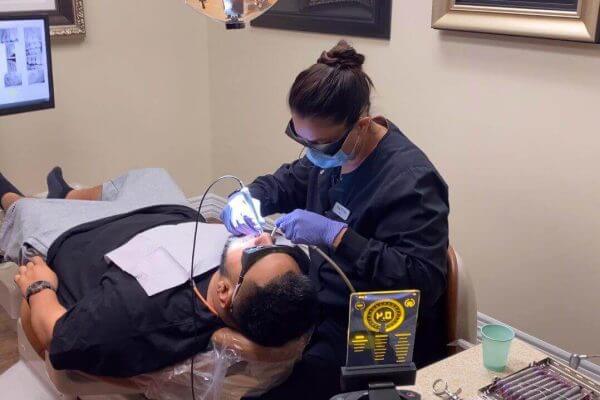Sanding Teeth During Invisalign Treatment Shows Positive Results
Interproximal Reduction (IPR) is the removal of interproximal enamel. The treatment aims to reduce the mesial-distal size of teeth, or in even simpler terms, to physically alter teeth when paired with braces or a set of teeth aligners in order to give patients the best orthodontic result.
Dr. Derek B. Hauser, DDS, is a leading cosmetic and family dentist in Riverside County and has been transforming families’ smiles for more than 20 years. Lakefront Family Dentistry uses Invisalign therapy to correct crooked and misaligned teeth. If your smile needs straightening, Contact Lakefront Family Dentistry at (951) 244-9495 or Request an Appointment Online Today!
Reasons to Consider IPR
IPR, or sanding teeth down, is an easy, quick procedure in which Dr. Hauser uses precise tools to alter the shape and size of your teeth, particularly on the sides where the teeth touch. There are three reasons to undergo this procedure.
- The lower or upper sets of teeth may naturally be the wrong size, causing them to fit unevenly.
- The shape of each individual tooth may not allow them to lie next to each other properly.
- IPR is effective in cases of moderate crowding, so tooth removal can be avoided.
When teeth are the appropriate sizes, the upper and lower sets fit together somewhat like gears. The upper teeth are slightly wider than the lower teeth because they fit on the outside of the lower set. This is obvious when comparing the size of the lower front teeth to the upper front teeth.
If upper teeth are too wide or if the lower teeth are too narrow, crowding of the upper teeth, or an overbite, or spaces in the lower arch may occur. If the upper teeth are narrower than they should be or if the lower teeth are too wide, then there will be spaces in the upper set, causing the lower set to crowd—or even worse—an under-bite.
In 1958, Dr. Wayne Bolton was the first dentist to scientifically explain an incompatible set of lower and upper teeth. Therefore, when a patient has upper and lower arches that do not match due to size, dentists say that the patient has a “Bolton discrepancy.”
Options for Correcting a Bolton Discrepancy
There are two ways to correct a Bolton discrepancy: by making the teeth in the small arch larger or by making the teeth in the large arch smaller. Patients usually have a lot of extra enamel between their teeth. By using very thin tools, an orthodontist can polish away small amounts of enamel to make the teeth fit better.
The term “dark triangles” describes two triangular shapes that form near the gum line. This happens when teeth do not fit next to each other properly.
The height of the gums between the teeth, as well as the shape of the teeth, determines the size of the triangle. Your dentist will be able to tell you how much each of these two variables contribute to your specific case, and whether or not IPR is right for you.
The last reason you should consider IPR is when there is too much crowding to align the teeth, but there is not enough reason to remove any. This procedure is a key aspect of aligner therapy, or Invisalign, which solves minor crowding without removing teeth.
Sanding teeth with Invisalign is an easy way to reduce crowding and create a smooth, flat tooth surface that everybody wants. By moving tiny amounts of excess enamel, Dr. Hauser can create a substantial amount of space for straight teeth.
Research shows that the use of IPR improves long-term results with no increase of sensitivity when the amount of enamel removed is negligible.
Ask Dr. Hauser if IPR Is Right For You
Dr. Hauser is an award winning dentist. He stays up to date with the latest technology and techniques in the field. His patients feel confident and comfortable at Lakefront Family Dentistry. Dr. Hauser will thoroughly examine your teeth to see what form of treatment is right for you. If you think sanding teeth down could be beneficial, Contact Lakefront Family Dentistry at (951) 244-9495 or Request an Appointment Online Today!




